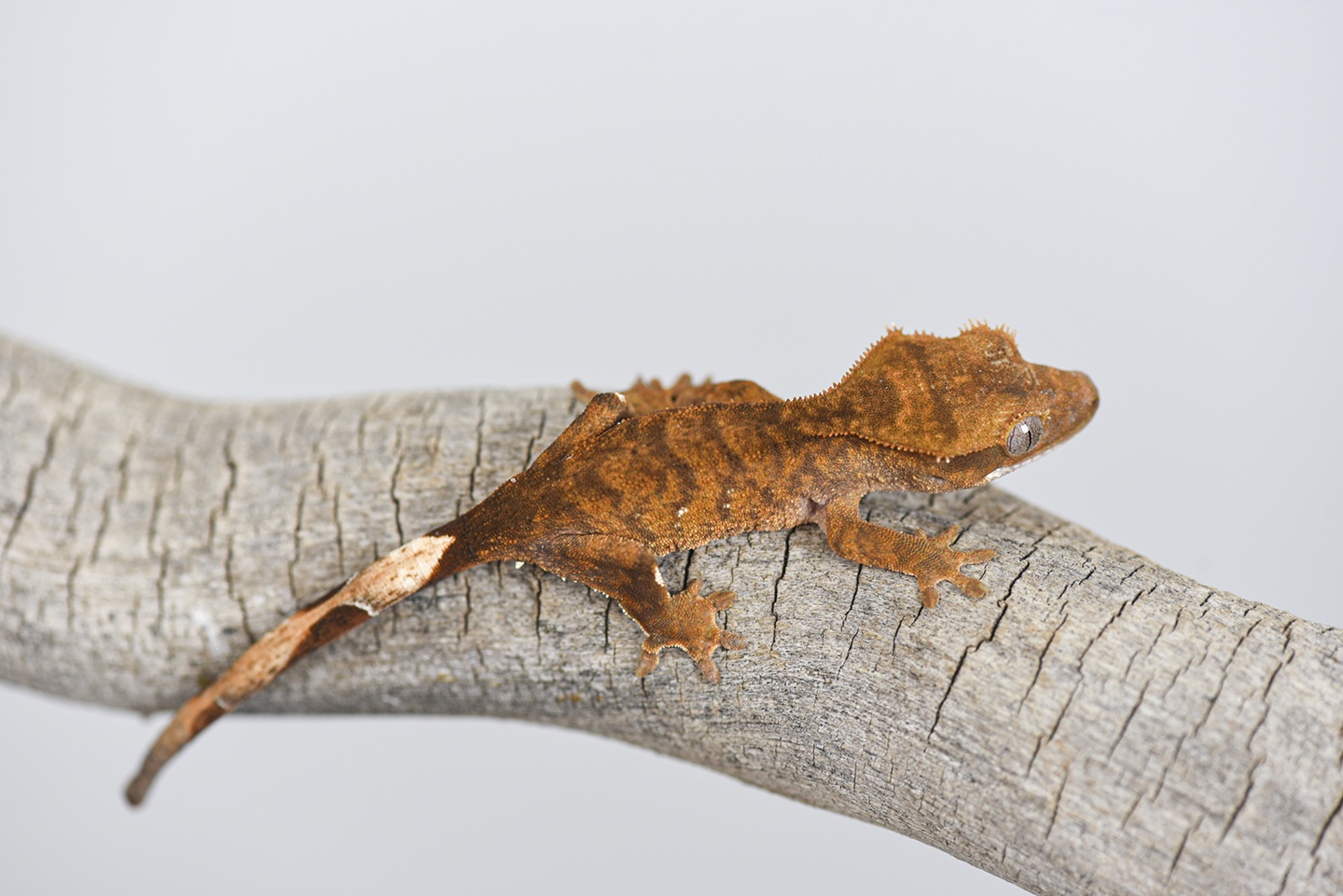Tiger
Type: Dominant
Aliases: Tigering, Bold Tiger Stripe
Issues: N/A
First Produced In: Unknown
Availability: Higher
Last Updated: 2025-01-31
Do you have any suggestions or corrections for this article?
Click here to contribute feedback
About
Tiger is an interesting gene, it is a fixed dominant mutation that is better described as a ratio. This means that the wild-type population has a single phenotype. In the reptile world, we call this the Normal morph. All other mutations have not survived through natural selection and only one morph has managed to survive and is dominant in the population. A Normal Ball Python is a great example as it is the Fixed Dominant morph found in the wild
A Tiger crested gecko will have a lighter base color with darker lines that run almost vertically from the dorsal down the laterals.
Tiger or tigering is the lowest common denominator trait that cannot be isolated from a crested gecko’s genes.
The current description of tiger , or Super tiger , describes dark bands on the animal. These tiger stripes can be thin or bold and stretch across the dorsum and lateral and sometimes go from one lateral over the dorsum to the other lateral. This gene is what we find to be most like aliens in Ball Pythons or the dark spots and patterning in leopard geckos. Several genes can affect tiger and how it modifies pattern. This gene is fixed in the population and cannot be removed. The development of tiger is similar to the BR morph in gargoyle geckos. Thicker tiger bands, and a larger expression of it, is a result of how it forms during development. It accounts for significant variation in siblings.
History
No history yet
Appearance
Head
The head is unaffected by this trait.
Body
The trait makes up everything from freckles inside pattern to bold thick bands, and thin small lines.
If we look at pattern distribution, migration, and disruption. Distribution is when you see excessive coverage in Harley morphs or yellow base animals or how it forms as reverse pin. Migration is when it pulls pattern through pins and it breaks pin or if it is oriented horizontally or vertically. For disruption we can look at walls and dorsal to see how it shatters the pattern this is the presence of tiger in pattern.
This contributes to banding and reticulation. As it is always there to some degree. The tigering in crested geckos contributes to how pattern breaks along the dorsal and the upper and lower laterals. This jagged pattern organizes and breaks pattern up vertically. The less horizontal pattern influence, the stronger the tigering will be and the more dominance it has over the direction of the animal’s pattern.
Tigering can be found significantly reduced showing small thin lines to freckles on solid-colored morphs to thick huge bands of pattern and breaks on dark base color.
Pattern is well described by Turing Patterns which describe a reactant and inhibitor. Pattern color is the reactant and tiger is the inhibitor. There are many YouTube videos that help with this concept. A stronger form of tiger will break apart pattern distribution. This perspective gives insight into how the pattern will develop based on parents and how to increase pattern or increase tiger markings to create the phenotype you desire.
Distribution, migration, and disruption are the primary factors for how it affects color pattern. Distribution is when tiger forms different-sized bands at different space values across areas of the animal. Pining causes tiger to be forced along the pin edge and pattern, forming what we call reverse pin. Migration causes pattern to move into different areas. Pattern follows the tiger’s edge and guides pattern into different areas of the animal. It forces flame pattern to migrate into the space between the tiger stripes. Pin affects the tigering , and breaks/shifts the stripes along the mid-lateral line, which is what is commonly referred to as brindle. Some nice flame patterns can also form when tiger pushes into the belly pattern. Disruption is when we see pattern break, shatter, or freckle in animals who are covered in pattern color.
Belly
The belly is unaffected by this trait.
Tail
The tail is unaffected by this trait.
Controversy
Brindle, tiger , freckling and reverse pinstripe is tiger , at work with different traits, making unique phenotypes. Since we previously missed tiger being the root cause of this, the hobby correlated these characteristics into traits, to try and describe the morph we see. This is the reason why we say tiger is a unifying term for all the previously mentioned names.
Proven Lines
Related Traits
Brindle, tiger , freckling and reverse pinstripe is tiger , at work with different traits, making unique phenotypes. Since we previously missed tiger being the root cause of this, the hobby correlated these characteristics into traits, to try and describe the morph we see. This is the reason why we say tiger is a unifying term for all the previously mentioned names.
Tiger is affected by pinstripe . Pinstripe and tiger have two separate and opposing directions of pattern development. Pinstripe orients color and pattern horizontally and tiger vertically. These two things clash and fight each other for dominance of the pattern development. Instead of saying an animal is or is not a tiger we describe them as having strong or weak tigering , based on interaction with other traits in the animal. Strong, or highly stacked, tigering , will display long heavier bands. While weak, or less stacked, tgering, will display smooth coloration on animals, sometimes with freckling, and have few breaks in the pattern color. This means we can also refer to it as a ratio between pinstripe and tiger , or a ratio of pattern to tiger . Full coverage animals usually have a weaker tger influence which causes freckling or small lines within the pattern. The stronger expression of pinstripe , due to selective breeding, results in tiger having a more difficult time breaking up pattern.









